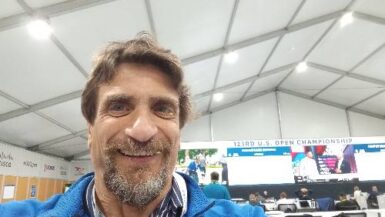
HAVEN, WI – Put together Pete Dye – who’s been called a “mad scientist,” “Bela Lugosi,” and “the scariest golf designer in the world” – and a major golf championship, and you’d think that the Tour pros would be in for a brutalizing like they get at places like Oakmont, Winged Foot, or Oakland Hills. After all, Pete’s not only the most visually intimidating golf architect of this or maybe any generation, he’s also a disciple of Golden Age designer Seth Raynor, so the cunning design of his strategic angles coupled with severe hazards should be lethal to scorecards.
Instead, the pros are tearing through Dye courses like Godzilla levels Japan. (Singing…OOOOOOOOOOOOH! THERE GOES TO-KY-O! GO, GO, GODZILLA!)
Whistling Straits was torn limb from limb this week by Jason Day. He got medieval on it – wringing its neck, then cutting open its chest and removing all the organs and then showing them to the crowd, before lopping off the head and feet, and burning the corpse for good measure. He shot four consecutive rounds in the 60s – 68-67-66-67=268 t be exact – for a total of 20-under, the lowest score to par in major championship history.
“20-under?” moaned shell-shocked golf expert Charles Cordova. “That’s just crazy! Whistling Straits is supposed to be a hard golf course.”
Supposed to be…But when there’s no wind, the course has been softened by rain the week of the tournament, and with equipment advances outstripping regulation efforts, even Pete Dye courses are defenseless. Worse, they’re cannon fodder, even with 1,000 bunkers, and the players were firing full broadsides and hitting the course below the waterline.
“A 220 hard 8-iron? Come on!” raged Cordova. “And Bubba hit a 400 yard drive on one hole!”
409 yards, to be precise, when he wasn’t busy being a wussie about not getting a free drop away from an anthill. (The video of him lamely trying to weasel out of a tough bunker shot is as funny as an Abbott and Costello routine.) But everyone got into the act: Rory, DJ, Day, pretty much everyone. Day’s driving distance for the week on holes where that statistic was officially measured exceeded 375 yards. Unofficially, he hit 11 drives of 325 yards or longer, six drives of 350 or longer and two drives of 400 yards. He played a 585-yard par-5 Driver, 9-iron and played at least two other 500-yard par-4s Driver, wedge.
It resulted in a bloodletting on the scorecard worthy of a Quentin Tarantino marathon, with a little Eli Roth thrown in for good measure. A whopping 16 players finished 10-under or lower, and 53 players finished under par. Pete Dye actually predicted pre-tournament that the winning score would be as high as 15 under, but Day reached that after just three rounds. And even with all the pins tucked as close to danger as possible, the players, (especially Day), simply launched shots over the trouble, parachuting them next to the pin. Look at some of these course statistics:
—A staggering eight holes played under par for the week. By contrast, at the U.S. Open usually only one hole plays under par for the week;
—On Saturday the field played Whistling Straits to a scoring average of 70.62. Par was essentially a stroke and a half less than on the scorecard;
—The field tallied 1,605 birdies for the week, (Day carded 25 birdies and two eagles himself. In fact, for three consecutive days he strung at least three birdies – or better! – in a row); and
—For the entire field over the course of the week, the scoring average was a paltry 72.5 – just a half stroke over par. Compare that to all the times Oakmont, Winged Foot, and Oakland Hills turned in scoring averages between four and seven strokes over par.
“It’s great to see eagles and birdies out there, but there’s also trouble around every corner,” explained PGA of America Chief Championships Officer Kerry Haigh. “The best players in the world are here, and we have pretty much set the golf course up for them to show their skills.”
“We are not afraid of birdies around here,” echoed former PGA of America President Allen Wronowski.
That’s fine. After all, nothing is more boring to the patrons to watch guys tiptoe around a minefield of unexploded double bogeys. These people pay good money to attend one of the game’s premier events, so they want to see the players at their best. Moreover, when you set up a golf course too hard, you let all the riff-raff into the party. It’s like putting a restrictor plate on the field – they all tend to bunch up and the guy who makes the fewest mistakes wins, no the player who hits the best shots.
See “Campbell, Michael,” for more on that.
But we also don’t want to see mighty Whistling Straits and fearsome Pete Dye get dismembered either. This is a major, not a silly season event, and the players turned Whistling Straits, the Castle Dracula of golf courses, into a merry-go-round.
So much for intimidating visuals! So much for 1,000 bunkers! So much for Lake Michigan! A couple of pros who will remain nameless were overheard joking near the caddie tent, “Hey! Who wants a piece of that total fish Pete Dye?”
But it’s not just Whistling straits getting filleted. Pete Dye golf courses have hosted five majors, all PGA Championships, and in four of those four, the winner has been double digits under par. Here’s a breakdown:
1991 Crooked Stick (John Daly, 12-under)
2004 Whistling Straits (Vijay Singh, 8-under)
2010 Whistling Straits (Martin Kaymer, 11-under)
2012 Kiawah Island-Ocean Course (Rory McIlroy, 16-under)
If there’s one thing these names all have in common, it’s ungodly length. It seems there is one inconvenient truth about Pete Dye courses: if you can bomb it over all the trouble, suddenly they are defenseless. Each of these majors is a perfect case study in that regard.
Crooked Stick was supposed to be impossible, but Daly played it like a Stradivarious from day one even though he hadn’t hit a single practice ball, and drove all through the night just to get to the first tee on time! He drove the ball over all the trouble the entire week, and enjoyed a leisurely waltz to victory. Vijay Singh has always been long, and it was a 310 yard drive onto the 10th green on the first playoff hole in the 2004 PGA that gave him a birdie, (where Justin Leonard and Chjris DiMarco had to lay up), and proved his eventual margin of victory. Kaymer and Bubba Watson were in a playoff in 2010, and each of them is notorious for gigantic…in Bubba’s case gargantuan…drives. And Rory turned supposedly unconquerable Kiawah Island into a pitch and putt.
“It’s the equipment. Somebody’s gotta do something about it,” he observed in a pre-tournament interview from the last time we were here for a PGA. “These guys are bigger, stronger, they’re more fit, and they’re swinging football helmets on sticks.” Now five years later and nine more shots under par, Dye’s words ring even truly.
“The quality of these players, and the length that these guys can hit the ball, combined with it being as soft as it is right now made for what we saw this week,” explained Whistling Straits PGA Head Professional Mike O’Reilly, who served as a marker for Charley Hoffmann in round three. “We had a lot of rain and humidity on Monday and Friday, so it wasn’t nearly as fast and firm as we needed it, and when a golf course is soft as this one is now, that makes the fairways and greens larger.”
Two consecutive Dye major championship courses have now yielded record scores: Rory Mcilroy broke Jack Nicklaus’s 37 year old record for largest margin of victory when he won the PGA at Kiawah Island’s Ocean Course by eight shots. Now Jason Day has passed Tiger’s mark of 19-under that Woods posted at the 2000 Open Championship at St. Andrews. One has to wonder if Pete Dye courses, while terrifying to look at and which both beguile and befuddle amateurs, are just too easy for the longest touring pros. It may answer the question as to “Why have PGA Championships been held at Dye courses, but never a U.S. Open?”
“If you’re driving the ball well on any Pete Dye golf course, you’re going to have a lot of short irons in, and you’re going to have a lot of looks. On this golf course there’s plenty of room off the tee, and there’s plenty of room on the greens, but you have to hit both of them, he will penalize you if you miss,” Tiger Woods surmised accurately. [Still,] if you’re in the fairway, or on the greens, you’re fine – especially at these temperatures, the ball’s flying forever. So it’s playing a lot shorter than the number,” he concluded. Add in hat there has never been any wind in August for here consecutive Whistling Straits PGAs, and all those hazards that horrify the amateurs disappear in the pro’s golfers Tunnel Vision, and suddenly the tournament becomes a lawn darts competition.
Happily, there is another side to that coin. Prior to Day’s victory, all four winners of majors hosted at Dye courses either were multiple major champions when they won, or becaue multiple major winners afterwards. In 1991 Daly won the PGA at Crooked Stick, then went on to win the Claret Jug at St. Andrews in 1995. Vijay won his third major here at Whistling Straits in 2004. Although the 2010 PGA was Martin Kaymer’s first major victory, he won the 2014 US Open in record fashion, blowtorching Pinehurst No 2 in the process. His opening 65-65 is still tied for the best opening 36 holes in major championship history. And not only did Rory McIlroy capture his second major at Kiawah, he won two more after that. So that bodes well for Day, who contends often and plays well on all surfaces on which majors are contested. It seems likely he’ll be in late Sunday pairings for a few years more at least.
Still something has to be done about the equipment. It’s one thing when the boys shoot 20-under at Innisbrook or La Quinta, but it’s altogether different to whip the Straits Course like that. To steal a bit of football jargon, Whistling Straits got exposed. All that bitching about Whistling Straits during the U.S. Open, yet the winning score was only 5-under. It makes you wonder which one is the stronger golf course. If there is one thing the PGA could do better, it’s to pick older more classic courses…ands modern courses that emulate classic courses. Whistling Straits tries, but in the interest of what Tour pros and panderers call “fairness,” all the things you need to defend par are erased. What golf at all levels needs is smaller greens, more green contours, and uneven lies in the fairway to defend par. A little less Medinah and Atlanta Athletic Club, a little more Oakmont and Merion.
What’s that you say? Oakmont’s next year! It can’t get here soon enough.
NEWS, NOTES, AND QUOTES
Great exchange between the scribes and Jordan Spieth:
Q: Was there one shot of Jason’s where you said, he’s just not able to be caught today? One specific shot?
SPIETH: The tee shot on 11….When he hit that tee ball, and I walked up and saw where it was, I turned to him. I actually out loud turned to him and said holy — you know, and I yelled it over to him, and I said you’ve got to be kidding me. And then he gave me a little bicep. And when he hit that shot and he had what looked like a wedge into the hole, I knew I was going to be playing uphill from there.
Justin Rose, the Laconic Prognosticator
“I thought -14 would be the winning score, and that’s ironic cause that’s what I shot…”
PICTURE CREDIT: THAT’S WHISTLING STRAITS PGA HEAD PROFESSIONAL MIKE O’REILLY IN THE PHOTO. THANKS FOR GRACIOUSLY SHARING THE MAGIC MOMENT WITH US.
PGA to Mike: Mike, you’re playing today.
Mike: Playing? Playing where?




